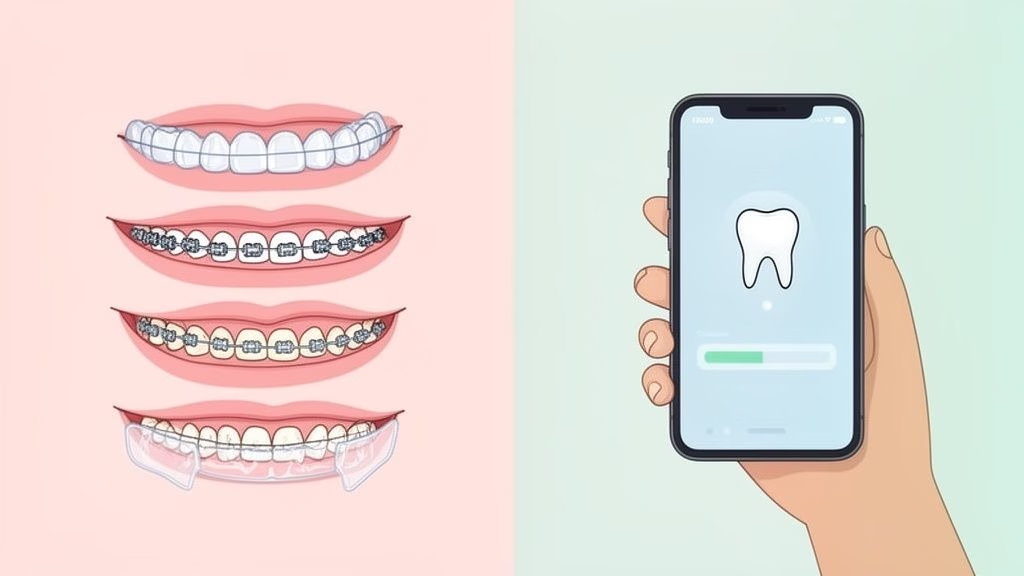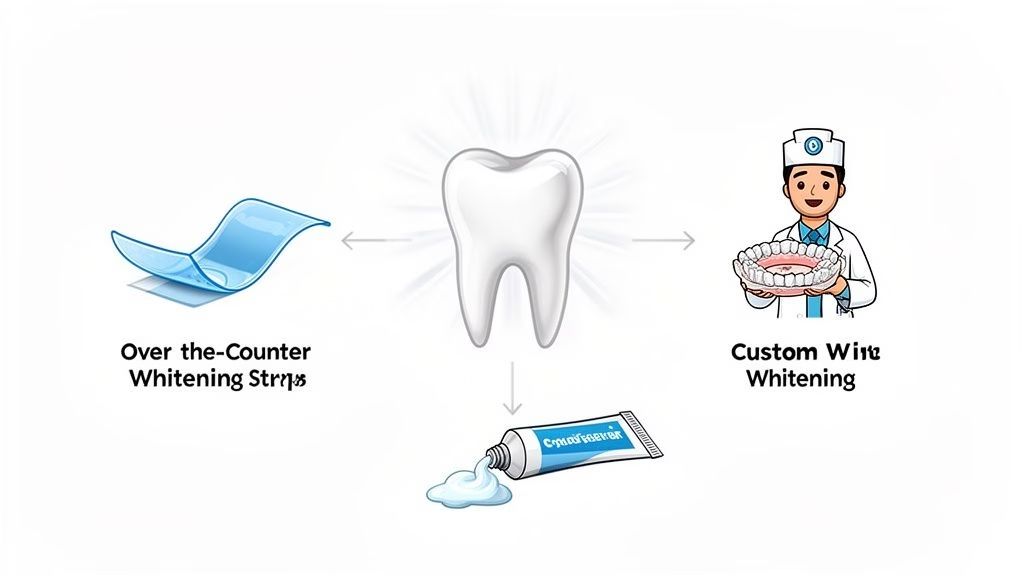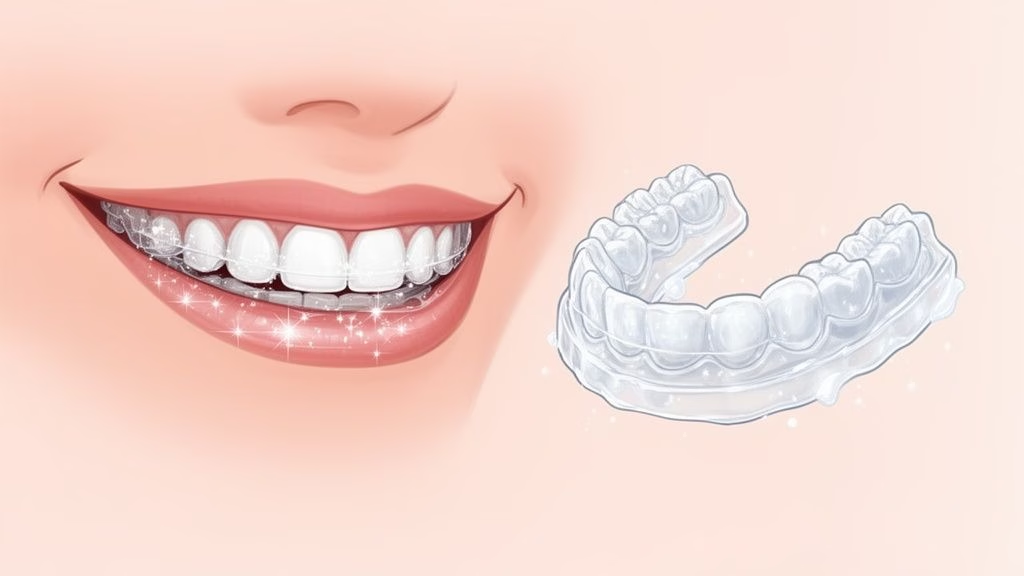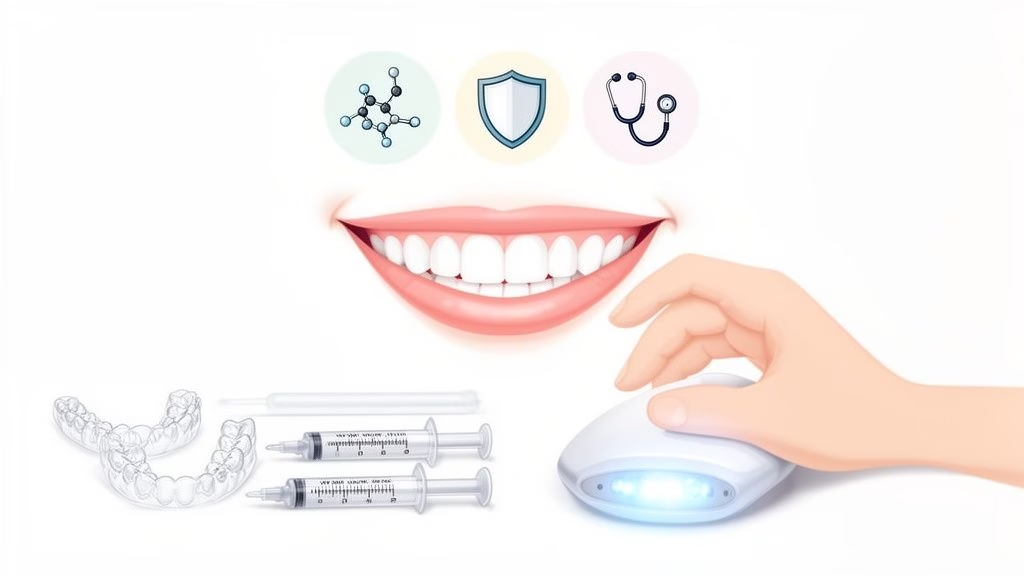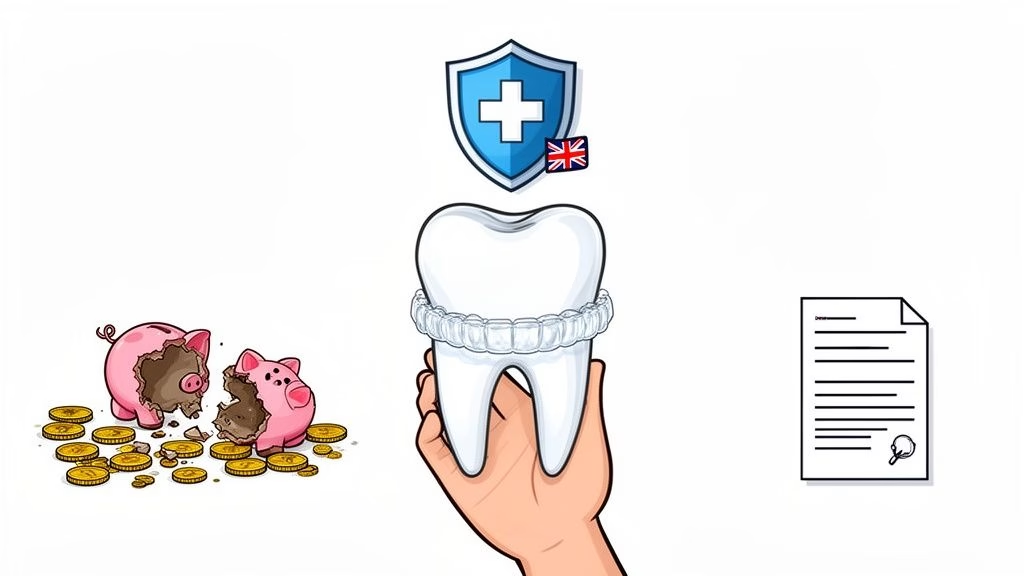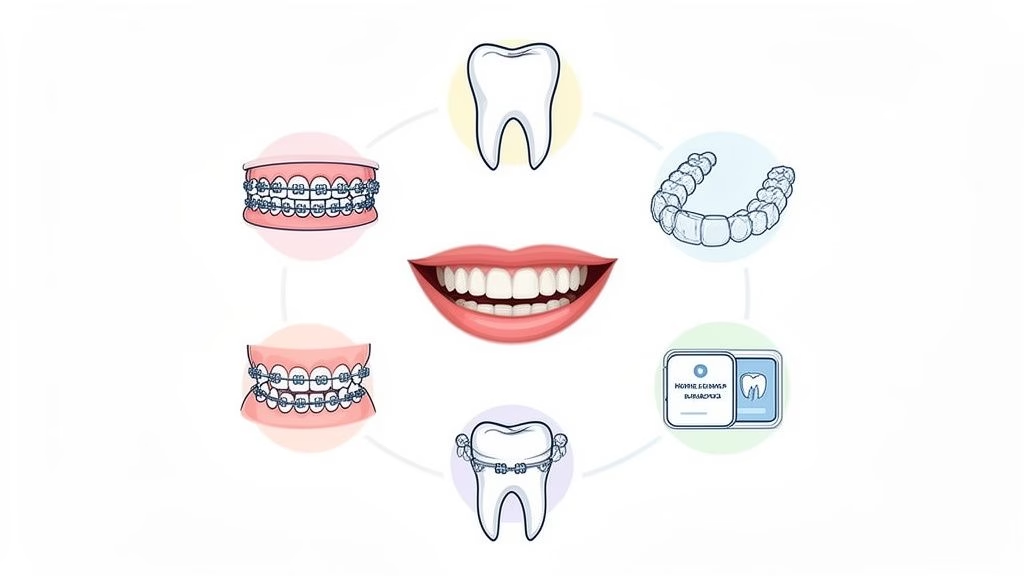How to Choose a Dentist in the UK

Choosing a new dentist is about more than just finding the nearest clinic. It’s about finding the right fit for your unique situation, whether you need routine family check-ups or have specific cosmetic goals in mind. A little bit of groundwork upfront can save you a world of trouble later.
First Things First: What Do You Really Need?
Before you even open a search engine, take a moment to think about your dental priorities. Are you looking for a reliable NHS practice for the whole family? Or is your main goal something specific, like getting your teeth professionally whitened? Maybe you’re laser-focused on straightening your smile.
Getting clear on this from the outset makes your search far more efficient. For instance, if you just want straighter teeth, a general dentist might offer a few aligner options among dozens of other services. But a specialised provider like Toothfairy offers a smarter and more affordable way to straighten teeth, manage dental emergencies, or get cosmetic dental work, letting you manage the process from the comfort of your home without the high costs of a traditional clinic.
This simple breakdown can help guide your thinking as you start your search.
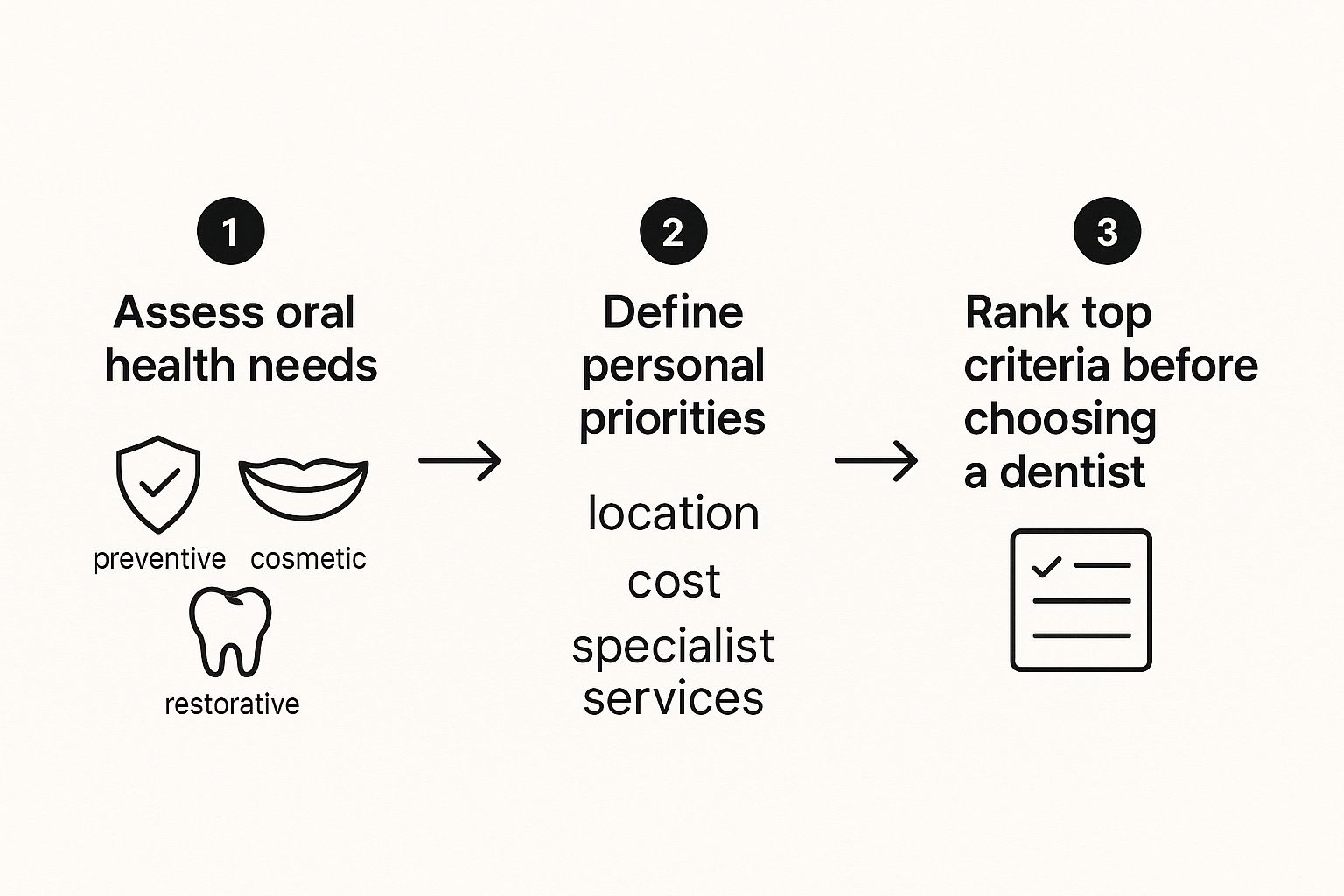
The real takeaway here is to nail down your core dental needs before you start worrying about practicalities like location or cost.
Building Your Shortlist
With your needs clearly defined, it’s time to create a list of potential practices. The best place to start is often the old-fashioned way: ask friends, family, or even your GP for recommendations. People are usually happy to share their good (and bad) dental experiences.
Beyond personal referrals, the official NHS website is an essential tool for finding and comparing local clinics that are actually accepting new patients. This is a critical step, especially given the current state of dental access in the UK.
Simply finding an appointment can be a major hurdle. Recent figures show that while about 52.1% of adults have an NHS dentist, a massive 90.6% of those without one couldn’t get an appointment when they needed it. You can explore more of this data on NHS dental access at ons.gov.uk.
Given this reality, always confirm a practice is taking on new patients before you add them to your list. It’s a small step that can save you a lot of time and frustration.
Checking Their Credentials and Making Sure They’re the Right Fi
Alright, so you’ve got a shortlist of potential dentists. Now it’s time to do a bit of digging to make sure they’re properly qualified and can actually help you achieve your goals. This isn’t just a box-ticking exercise; it’s about establishing trust.
First things first, every single dentist in the UK must be registered with the General Dental Council (GDC). Think of it as their official licence to practise. Luckily, you can check anyone’s status in seconds on the GDC’s online register. It’s a simple check that confirms they meet the national standards for training and professional conduct. No registration? No appointment. It’s that simple.
Do They Offer What You Actually Need?
Once you’ve confirmed their credentials, the next question is whether their services align with your personal aims. It’s easy to assume all dentists do the same things, but that’s not really the case. A brilliant family practice that’s fantastic with kids and fillings might not be the best place for complex cosmetic work.
You need to match the dentist’s expertise to your specific needs. What are you hoping to achieve?
- Routine Care: If you just need regular check-ups, hygiene appointments, and the occasional filling, a great general or family dentist is perfect.
- Cosmetic Upgrades: Dreaming of professional teeth whitening, veneers, or composite bonding? You’ll want a practice that showcases a lot of cosmetic work and has a dentist with a real passion for aesthetics.
- Teeth Straightening: Getting a straighter smile is a major goal for many, and this is where the treatment models can really differ.
A traditional dental practice might offer clear aligners from a specific brand as one of many different treatments. But what if straightening is your only goal? This is where a more focused provider like Toothfairy can be a game-changer, offering a smarter and more affordable path to a straighter smile.
Specialist services that focus on one thing—like clear aligners—can cut out the high overheads of a traditional multi-purpose clinic. This allows them to deliver top-notch results for a specific goal at a significantly lower cost. Their entire process is built around doing that one thing exceptionally well.
This is a really important point. For specific goals like orthodontics, choosing a dedicated specialist often means you get a more efficient, focused experience and better value for your money. Their entire system is fine-tuned to deliver that one outcome, from the initial consultation to the final result.
Location and Technology: Making Dental Care Fit Your Life
A top-notch dentist is great, but not if their clinic is a logistical nightmare to get to. Before you sign up, really think about the practical side of things. How much of a mission is it to get there from your home or office? And what about their opening times – do they align with your schedule, or are they only open when you’re stuck at work?
These aren’t minor details. If every appointment requires a frantic dash across town in rush-hour traffic, you’ll be tempted to put off those crucial routine check-ups. That’s how small issues can turn into bigger, more painful problems. Pull them up on a map and imagine the journey on a typical Tuesday afternoon.
Look Beyond the Postcode
These days, a convenient practice is about more than just easy parking. The technology a clinic uses tells you a lot about their approach to patient care and efficiency. A surgery that feels like it’s stuck in the 90s can make the whole experience more clunky and stressful than it needs to be.
Here are a few signs of a practice that’s keeping up with the times:
- Digital X-rays: A huge plus. They use far less radiation than the old-school film versions and the images are available instantly.
- Online Systems: Being able to book an appointment or ping over a quick question online is a massive time-saver.
- Teledentistry: For minor queries or follow-ups, can you hop on a quick video call instead of taking a half-day off work?
This is where you see some services really innovating. Our platform like Toothfairy, for example, uses tech to completely rethink the need for constant clinic visits for certain treatments.
By sending you an at-home impression kit and using an app to monitor your teeth straightening progress, they make the whole process fit around your schedule. It’s a perfect example of making advanced dental care work for you, saving you from countless trips back and forth to a physical surgery.
When you see a practice investing in modern tools, it’s a strong signal that they value your time and are committed to making your care as smooth and patient-friendly as possible.
Decoding Dental Costs and Payment Plans
Let’s be honest, for most people, the final decision often boils down to the numbers. Understanding dental costs in the UK can be a minefield, especially when you start comparing the set fees of the NHS against the wide-ranging prices of private care.
Before you commit to anything, make it a rule to ask for a fully itemised treatment plan. This isn’t being difficult; it’s being smart. The document should clearly break down every single procedure and what it costs. A practice that values transparency will have no problem providing this, helping you avoid nasty surprises down the line.
Don’t hesitate to talk about payment, either. Many private practices offer flexible options, like monthly payment plans or partnerships with dental insurance providers, to make treatments more affordable. How a clinic handles the financial conversation says a lot about its approach to patient care.
Making Cosmetic Goals More Affordable
The price difference really hits home when you look at cosmetic treatments, such as teeth straightening. This is where exploring different service models can seriously benefit your bank balance. Think about a traditional clinic—they have to cover rent, staff salaries, and expensive equipment, and all of that gets baked into the price of your aligners.
This is exactly why direct-to-consumer services are shaking things up. By taking the process online and managing it remotely, providers like Toothfairy can slash many of those clinic-based overheads.
The result? A far more accessible price point for the same high-quality result. By specialising in teeth straightening and working directly with you, they deliver professional, dentist-led care without the hefty price tag you’d find on the high street.
This modern approach puts a straighter smile within reach for many more people. It’s a perfect example of how thinking outside the box and looking beyond your local clinic can lead to a smarter, more cost-effective way to meet your dental goals. Always remember to compare the total treatment cost, not just the brand name on the box.
Reading Between the Lines of Patient Reviews
A dentist’s qualifications and list of services tell you what they can do, but patient reviews tell you how they actually do it. This is where you get the real story. Sifting through patient feedback gives you insights a clinic’s glossy brochure or website will never reveal.
Don’t just stick to one source. Check out Google Reviews, the official NHS website, and even local community forums to get a well-rounded picture. It’s tempting to just look at the star rating, but the magic is in the comments. That’s where you’ll find the details that matter.
Spotting the Patterns That Count
One five-star review or a single furious complaint doesn’t paint the whole picture. What you’re really looking for are patterns. Do multiple people mention how patient Dr. Evans is with nervous clients? That’s a huge green flag.
On the flip side, recurring complaints are a serious warning. If you see several people mentioning long waits, feeling rushed, or dealing with unhelpful reception staff, you should probably listen. Every practice gets the odd negative comment, but a consistent theme points to a real, ongoing issue that you’ll likely run into yourself.
Real-world feedback is your most powerful tool. It cuts through the marketing fluff and tells you what it’s actually like to be a patient there, helping you make a choice you feel confident about.
Patient satisfaction is a tangible measure of quality, and it can vary wildly. For example, a recent survey found that satisfaction with NHS dental services can differ by region. In Suffolk and North East Essex, it climbed to 68%, closing in on the 71% national average. This shows just how much the patient experience can be a key performance indicator for a practice. You can explore these patient satisfaction findings in more detail.
Keep an eye out for reviews that get specific. A comment like, “Dr Smith took the time to explain all my options for my crown without any pressure,” is far more telling than a vague, “Great dentist!” This kind of detailed feedback helps you build a mental picture of the practice before you even pick up the phone.
Making the Final Choice with Confidence

You’ve done the research, weighed your options, and now it’s time to commit. Honestly, the best way to make your final call is to book an initial consultation or even just a simple check-up. Think of it as a test drive before you sign up for years of dental care.
This first appointment is your chance to get a real feel for the place. What’s the vibe like? Is the reception team friendly and efficient, or does it feel chaotic? These little things really add up and can make all the difference between dreading your appointments and feeling completely at ease.
Trusting Your Gut
Getting to meet the dentist and their team in person is invaluable. This is your moment to ask any lingering questions, but more than that, it’s about seeing if you click. Do they actually listen to you? Do you feel respected? A good relationship with your dentist is built on trust and clear, two-way communication.
Your intuition is a powerful tool here. If something just feels off—maybe you feel rushed, or your concerns are brushed aside—it’s absolutely fine to thank them for their time and try the next practice on your list. The right fit is out there.
It’s worth remembering that you have more options now than ever before. For regular check-ups and family dentistry, a great local practice is often the perfect solution. But for more specific goals, it pays to look at modern alternatives.
For instance, if your main goal is cosmetic—like finally getting that straighter smile—a specialist service like Toothfairy could be a much smarter, more affordable route. They focus solely on treatments like clear aligners and manage much of the process remotely. This gives you a convenient and cost-effective way to get professional results, often bypassing the hefty price tags of big-name aligner brands you’d find at a traditional clinic.
Got a Few Questions? Let’s Clear Things Up
Choosing a new dentist can throw up some common questions. I get asked these all the time, so let’s run through some quick answers to help you feel confident in your decision.
Can I Be Registered With Both an NHS and a Private Dentist?
You certainly can. Many people do this. It’s perfectly fine to use an NHS dentist for your routine check-ups and hygiene appointments, and then see a private specialist for treatments not covered by the NHS, like cosmetic bonding or high-end veneers.
Some practices even offer both NHS and private services under one roof, which gives you the flexibility to mix and match as you need to.
How Often Should I Really Be Seeing a Dentist?
That old “every six months” rule is more of a general guideline than a hard-and-fast rule for everyone. The truth is, your visit frequency should be based on your personal oral health.
Your dentist will assess your risk for things like gum disease and cavities and recommend a schedule that’s right for you. This could mean a check-up every three months if you’re high-risk, or it could be as long as two years if your teeth and gums are in great shape. It’s always best to follow their professional advice.
It’s also worth asking a potential dentist about their approach to preventative care. Do they discuss things like diet and the benefits of quitting sugar to protect your teeth in the long run?
Ready to explore a smarter, more affordable way to achieve your dental goals? With Toothfairy, you can access dentist-led cosmetic treatments, teeth straightening, and even emergency care right from your phone. Find out more at https://www.toothfairyapp.co.uk.
Last updated on August 22, 2025

Toothfairy Care Team
Toothfairy, is the world's smartest dental app, that connects patients to a dentist for a range of issues, from emergencies, cosmetics, prescriptions to virtual exams.
Toothfairy Care Team
Toothfairy, is the world's smartest dental app, that connects patients to a dentist for a range of issues, from emergencies, cosmetics, prescriptions to virtual exams.
